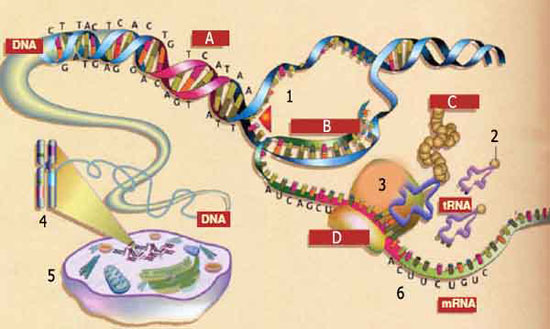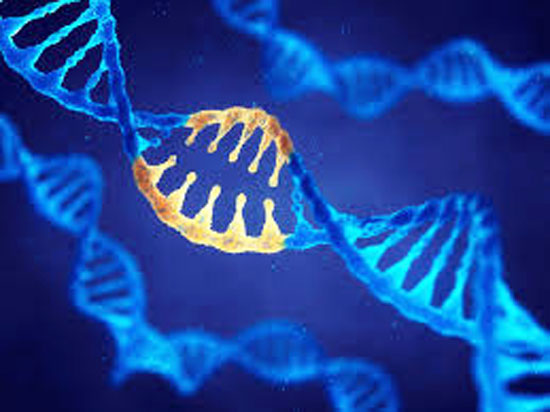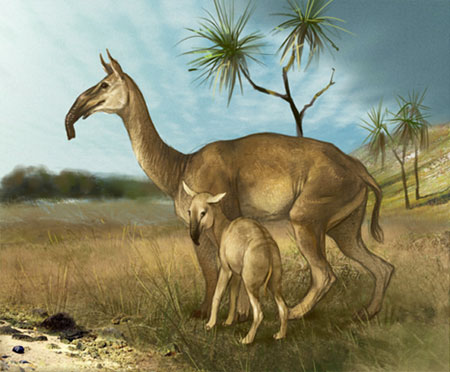Professor Explains Why He Believes Darwin’s Theory of Evolution Doesn’t Make Sense (2)
Read the first part of the article
Diving Into Proteins

Are random mutation plus natural selection
sufficient to create new protein shapes? Gelernter goes on to answer that question
in great detail, and after going through the entire explanation he comes to what
seems to be an inarguable conclusion. That the Theory of Evolution cannot, in any
way, be a possible explanation for the generation of new proteins and mutations that
are required for evolution to occur at all.
This explanation is complex, but well worth it if
you really want to understand how the ‘Theory of Evolution’ is refuted
by the science of proteins:
‟How to make proteins is our first
question. Proteins are chains: linear sequences of atom-groups, each bonded to the
next. A protein molecule is based on a chain of amino acids; 150 elements is a
‘modest-sized’ chain; the average is 250. Each link is chosen,
ordinarily, from one of 20 amino acids. A chain of amino acids is a polypeptide
– ‘peptide’ being the type of chemical bond that joins one amino
acid to the next. But this chain is only the starting point: chemical forces among
the links make parts of the chain twist themselves into helices; others straighten
out, and then, sometimes, jackknife repeatedly, like a carpenter’s rule, into
flat sheets. Then the whole assemblage folds itself up like a complex sheet of
origami paper. And the actual 3-D shape of the resulting molecule is (as I have
said) important.
Imagine a 150-element protein as a chain of
150 beads, each bead chosen from 20 varieties. But: only certain chains will work.
Only certain bead combinations will form themselves into stable, useful, well-shaped
proteins.ˮ
So how hard is it to build a useful, well-shaped
protein? Can you throw a bunch of amino acids together and assume that you will get
something good? Or must you choose each element of the chain with painstaking care?
It happens to be very hard to choose the right beads.
Inventing a new protein means inventing a new
gene. (Enter, finally, genes, DNA etc., with suitable fanfare.) Genes spell out the
links of a protein chain, amino acid by amino acid. Each gene is a segment of DNA,
the world’s most admired macromolecule. DNA, of course, is the famous double
helix or spiral staircase, where each step is a pair of nucleotides. As you read the
nucleotides along one edge of the staircase (sitting on one step and bumping your
way downwards to the next and the next), each group of three nucleotides along the
way specifies an amino acid.
Each three-nucleotide group is a codon, and the
correspondence between codons and amino acids is the genetic code. (The four
nucleotides in DNA are abbreviated T, A, C and G, and you can look up the code in a
high school textbook: TTA and TTC stand for phenylalanine, TCT for serine, and
so on.)
Your task is to invent a new gene by mutation
– by the accidental change of one codon to a different codon. You have two
possible starting points for this attempt. You could mutate an existing gene, or
mutate gibberish. You have a choice because DNA actually consists of valid genes
separated by long sequences of (apparent) nonsense.
Most biologists think that the nonsense sequences
are the main source of new genes. If you tinker with a valid gene, you will almost
certainly make it worse – to the point where its protein misfires and
endangers (or kills) its organism – long before you start making it better.
The gibberish sequences, on the other hand, sit on the sidelines without making
proteins, and you can mutate them, so far as we know, without endangering
anything.
The mutated sequence can then be passed on to the
next generation, where it can be mutated again. Thus mutations can accumulate on the
sidelines without affecting the organism. But if you mutate your way to an actual,
valid new gene, your new gene can create a new protein and thereby, potentially,
play a role in evolution.
Mutations themselves enter the picture when DNA
splits in half down the center of the staircase, thereby allowing the enclosing cell
to split in half, and the encompassing organism to grow. Each half-staircase summons
a matching set of nucleotides from the surrounding chemical soup; two complete new
DNA molecules emerge. A mistake in this elegant replication process – the
wrong nucleotide answering the call, a nucleotide typo – yields a mutation,
either to a valid blueprint or a stretch of gibberish.
Building a Better Protein

Now at last we are ready to take Darwin out for a
test drive. Starting with 150 links of gibberish, what are the chances that we can
mutate our way to a useful new shape of protein? We can ask basically the same
question in a more manageable way: what are the chances that a random 150-link
sequence will create such a protein? Nonsense sequences are essentially random.
Mutations are random. Make random changes to a random sequence and you get another
random sequence. So, close your eyes, make 150 random choices from your 20 bead
boxes and string up your beads in the order in which you chose them. What are the
odds that you will come up with a useful new protein?
It’s easy to see that the total number of
possible sequences is immense. It’s easy to believe (although non-chemists
must take their colleagues’ word for it) that the subset of useful sequences
– sequences that create real, usable proteins – is, in comparison, tiny.
But we must know how immense and how tiny.
The total count of possible 150-link chains,
where each link is chosen separately from 20 amino acids, is 20150. In other words,
many. 20150 roughly equals 10195, and there are only 1080 atoms in the
universe.
What proportion of these many polypeptides are
useful proteins? Douglas Axe did a series of experiments to estimate how many 150-
long chains are capable of stable folds – of reaching the final step in the
protein-creation process (the folding) and of holding their shapes long enough to be
useful. (Axe is a distinguished biologist with five-star breeding: he was a graduate
student at Caltech, then joined the Centre for Protein Engineering at Cambridge. The
biologists whose work Meyer discusses are mainly first-rate Establishment
scientists.)
He estimated that, of all 150-link amino acid
sequences, 1 in 1074 will be capable of folding into a stable protein. To say that
your chances are 1 in 1074 is no different, in practice, from saying that they are
zero. It’s not surprising that your chances of hitting a stable protein that
performs some useful function, and might therefore play a part in evolution, are
even smaller. Axe puts them at 1 in 1077.
In other words: immense is so big, and tiny is so
small, that neo-Darwinian evolution is so far a dead loss. Try to mutate your way
from 150 links of gibberish to a working, useful protein and you are guaranteed to
fail. Try it with ten mutations, a thousand, a million you fail. The odds bury you.
It can’t be done.
Proteins/Mutations Are One of Several
Issues
Despite all of the scientific dogma that plagues
this issue, proteins/mutations and lack of fossil evidence are simply the tip of the
iceberg when it comes to finding faults found within the Theory of Evolution. There
are many facts, information, science and new discoveries that would make one wonder
how it’s even still being taught.
Furthermore, despite the fact that we get pounded
with the idea that random mutation is ultimate truth within the mainstream, and that
one is wrong for questioning it, there are a number of prominent scientists, who are
actually getting together in large numbers to collectively refute Darwinism. A group
of 500 scientists from several fields came together a few years to create “A
Scientific Dissent From Darwinism,” as one examples. The issue is that these
scientists are never getting any mainstream attention. But clearly there are some
very intelligent people here.
The theory will be with us for a long time,
exerting enormous cultural force. Darwin is no Newton. Newton’s physics
survived Einstein and will always survive, because it explains the cases that
dominate all of space-time except for the extreme ends of the spectrum, at the very
smallest and largest scales. It’s just these most important cases, the ones we
see all around us, that Darwin cannot explain. Yet his theory does explain cases of
real significance. And Darwin’s intellectual daring will always be inspiring.
The man will always be admired.
He now poses a final challenge. Whether biology
will rise to this last one as well as it did to the first, when his theory upset
every apple cart, remains to be seen. How cleanly and quickly can the field get over
Darwin, and move on? – with due allowance for every Darwinist’s having
to study all the evidence for himself? There is one of most important questions
facing science in the 21st century.
Other Examples That Throw Off The Theory
Of Evolution

A paper published by 33 scientists in the
Progress in Biophysics and Molecular Biology journal suggests that the
flourishing of life during the Cambrian era (Cambrian Explosion) originates from the
stars is somehow fascinating.
“With the rapidly increasing number of
exoplanets that have been discovered in the habitable zones of long-lived red dwarf
stars (Gillon et al., 2016), the prospects for genetic exchanges between life-
bearing Earth-like planets cannot be ignored. ”
There is a great little blurb from Cosmos
Magazine, one of the few outlets who are talking about the study:
With 33 authors from a wide range of reputable
universities and research institutes, the paper makes a seemingly incredible claim.
A claim that if true, would have the most profound consequences for our
understanding of the universe. Life, the paper argues, did not originate on the
planet Earth.
The response?
Near silence.
The reasons for this are as fascinating as the
evidence and claims advanced by the paper itself. Entitled “Cause of the
Cambrian Explosion – Terrestrial or Cosmic?”, the publication
revives a controversial idea concerning the origin of life, an idea stretching back
to Ancient Greece, known as ‘panspermia’.
Academics like Francis Crick, an English
scientist who co-discovered the structure of the DNA molecule (alongside James D.
Watson), argues that there is no possible way that the DNA molecule could have
originated on Earth. The generally accepted theory in this field, as explained
above, is that we are the result of a bunch of molecules accidentally bumping into
each other, creating life. However, according to Crick, we are the result of what is
now known as Directed Panspermia. Crick and British chemist Leslie Orgel published
their paper on it in July of 1973, hinting that we were brought here by chance, or
by some sort of intelligence from somewhere else in the universe.
This is interesting, because then you can get
into the lore of creation stories that exists within ancient cultures from around
the world, one would be our relation to, for example, what many indigenous culture
refer to as the ‘Star People.’
Couls be also mentioned the strange skeletal
remains that have been completely left out of the record, like the remains of
giants, for example.
The Takeaway
The agenda for the maintenance of the neo-
Darwinian version of the ‘Theory of Evolution’ was nothing less than to
move people away from the notion of an intelligent creator and towards a perception
founded in scientific materialism. In this way, those who funded and controlled
scientific activity on the planet would have tremendous power.
Darwin’s theory may have served humanity
for a certain phase of our own evolution, but now it is holding us back. It’s
time for all of us to pierce more deeply into an understanding of the nature of the
creation of life if we are to become creators ourselves by studying the current
evidence.
yogaesoteric
March 26, 2020
Also available in:
 Français
Français
